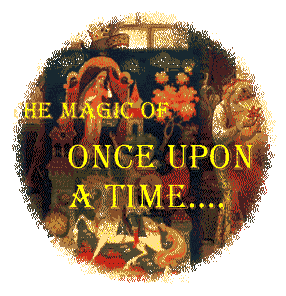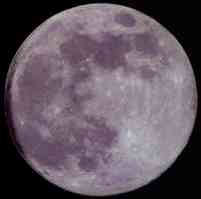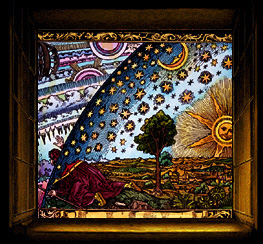|

Narrative Logo - Click for Main Menu
Lecture VI: The Ancient Skies and the Origins of the World
Theories
about Origin Tales

The Sky as First Drama
Here, of course, is where the "ancient
skies" come in again, very strongly. The heavenly bodies often figure
prominently in the folklore of origin. Mircea Eleade, in an essay entitled "The
Moon and Its Mystique" observes, as does Krupp, the elementary importance of the moon
for ancient cultures. Eliade stresses the symbolic relationship of the moon to the
waters of creation, the snake figure, fertility both in heaven and on earth, and the
creative power of the female force. The moon and the contemplation of the moon
serves, in many cultures, to allow man to access the unity of the cosmos. And, of
course, the moon goddesses are often associated with weaving or were said to invent
it - and the weaving, in turn, is symbolic of the creation of the world. The moon,
then, or the force of the moon, is often seen as the metaphoric center of Origin tales.
In a chart of moon-goddess names from several cultures, we can see how widespread
the moon stories are:
Moon Goddesses
see also Myths of the Moon
for these stories
The current moon phase is: waning to Dark

Caption: The Man in the Moon
visible in the real
craters of the Moon
Africa: Araua, Arava, Bomu Rambi, Buruku, Haine,
Isamba, Jezanna, Lisa, Mahu, Mawa,
Mawu, Mweji, Namboa, Nasilele, Nyadeang, Nyame, Nyingwan Mebege, Obosom, Ol-apa, Oshu, Pe, Quabso, So, Tano
The Americas (North, South, Central, Caribbean):
Aataentsic, Acna, Aialila'axa, Aquit, Changing Woman, Chia, Coatlicue, Coyolxauhqui,
Cutzi, Erzulie, Geyaguga, Hanwi, Hun-Ahpu-Mtye, Hunthaca, Ilamatecuhtli, Itzcueye, Ix Ahau, Ix Chebel Yax, Ix Chel, Ix ch'up,
Ixcuina, Ixcuiname, Ix U Sihnal, Ka-ata-killa, Kawas, Kikewei p'aide,
Kokomikeis, Komorkis, Man-el, Masahkare, Nipa, Ochu, Onchi, Pah, Paxsi, Perimbo,
Quilla, Sedna, Si, Tamparawa, Tarqeq, Tcalyel, Tetevinan, Toru-guenket, Wa-kon-da
Hondon, Xaratanga, Xquic, Yai, Yaonan, Yemaya, Yerugami, Yolkai Estsan, Yopue
Eastern Europe (Serbia, Russia, Slavic, Etc.):
Breksta, Hov-ava, Lusin, Myesyats, Piegulas mate, Poludnitsy, Teleze-awa
Egypt: Anatis, Ashtoreth, Bast, Hagar,
Hathor, Isis, Kek-t, Kerhet Nephthys, Qetesh
Far East (China, Japan, Korea, etc.): Chang E, Ch'
Ang-O, Chang Xi, Chiang, Chuh Kamuy, Kaguya-hime-no-mikoto,
Shingo-Moo, Taiyin, Yuefu Taiyin
Greek and Roman (Classical): Anna Perenna,
Antevorta, Aphaea, Aphrodite, Aradia, Artemis, Asterodeia, Atropos, Bendis, Briseis, Britomartis, Brizo, Callisto, Canidia, Circe, Demeter,
Diana, Europa, Electryone, Fana, Hecate, Helena, Hera, Io, Jana, Juno, Lalal,
Losna, Lucifera, Lucna, Luna, Mene, Munychia, Pamphile, Pandia, Pasiphae,
Persephone, Phoebe, Prosymna, Selene, Tanit, Zirna
India: Anumati, Brisaya, Candi, Chandi Mata,
Gomaj, Gungu, Ilura, Inda, Jyotsna, Kuhu,
Mata, Mgigalekha, Nakshatras, Ning-Bonga, Paurnamasi, Raka, Sarasvati,
Sasilekha, Sinavali, Sushumna, Susime
Near East (Babylonia, Mesopotamia, Persia, etc.):
Al-Lat, Anahita, Ashima, Ashimbabbar, Ashtaroth, Astarte, Baalith, Belili,
Caelestis, Derketo, Hapantili, Hur-ki, Inanna, Ishtar, Jerah, Lilith, Lusin, Metra, Nanna,
Nikkal, Nuah, Ri, Sadarnuna, Sirdu, Tanit Pene Baal, Telita
Teutonic (Norse, Celtic, etc.): Aine, Albina, Anu,
Arianrhod, Annis, Becuma, Borghild, Branwen, Brigantis, Brigit, Carridwen, Cybele, Danu, Dubh Lacha, Etain Echraidhe, Findbhair, Freya,
Frigga, Holle, Ilazki, Illargui, Morgana, Morgause, Re, Sadb, Ursula
Oceania (Australia, Polynesia, Micronesia, etc.):
Hainvwel, Hana, Hina, Hina hanaia'i ka malama, Hina nui te'a'ara, Hina papa i kua, Hina
uri, Hina'i a'a i te marama, Hine te iwaiwa, Hintubuet, Ina maram,
Kui o hina, Marama, Rona, Sina, Taio, Tapa
Southeast Asia (Philippines, Indonesia, Malaya, etc.):
Bulan, Dewi Ratih, Duan Luteh, Funan, Indo nTegolili, Ja Najek, Jara Meng, Kundui, Lingan,
Luyong Baybay, Mayari, Nenak Kebajan, Nini Anteh, Omonga, Rabia, Ratih

The Drama of Tooth and Claw
Joseph Campbell, in an essay entitled "The
Emergence of Mankind" takes a quite different tack with regard to ancient tales of
Origin. It's instructive to see how these different approaches carry, within, a
different set of assumptions about the function of folklore altogether. Campbell sits
more on the side of Marvin Harris in that he tells us about the Functions of myth, that
is, how they serve the societies that invent them. He also puts more
emphasis on the local geographical and environmental factors that might shape Origin
concepts.
Campbell begins with Neanderthal man as a starting
point for investigating the function of Origin tales. Already, we have an idea of
supernatural power being invoked - in the elaborate burials, grave goods, tools, sacrificed
animals, flowers, and so forth. Also, there are chapels in high mountain caves and
under the sea, even, that attest to a connection with ideas of mortality. These
ideas of mortality would seem to mean that these ancient cultures possessed a
self-conscious notion of identity that would imply a creation, as well.
He begins with the Bear Cults - and we find the Bear as
a creator figure (especially as a representative of the Dipper, in several of the ancient
Origin tales). Campbell then links the Bear Cult to fire, as well. He points
out that the Neanderthals did not use the fire for cooking - rather, he theorizes, fire was
a source of wonder, an altar, a sign of the creative force. In each of the examples
he gives, the images and symbols of bear, moon, fertility goddess, and so forth are ways
that the ancient peoples defined and attempted to harness the power of nature.

Medieval Illustration of the cosmos
with the Sun and the Seven Spheres
But the question that is more important,
perhaps, to Campbell is whether or not all of these cross-motifs represent a shared
history or a local response to their own environment.
Campbell's work directs us to look
to the universal elements of each tale -- he says that he, himself, has been at work on
"separate chapters of a single mythological epic of the human imagination." And
he also wants us to identify the local metaphors by which these elementary symbols have
been connected. In each of the Origin stories we will usually find both--the
universal and the hierophantic (as termed by Eliade).
It is in the interaction of these
two characteristic features of Origin tales that we can begin to study forms and interpret
meaning.
An Inca Example:
One more
account tells of the ancestors of the Incas coming out of a cave, called Pacaritampu,
after the flood and populating the earth. There is confusion as to whether the Incas were
first
created inside of Pacaritampu by Viracocha, or if this is just the place in which they
took refuge
from the flood. All the people of the earth, then, were descendants of the Incas.
This
belief is part
of the reason that the Incas were able to build such a vast and powerful empire, as this
would
make all of its followers an important part of the empire.
According to Navajo mythology:
the Milky Way was created by the mischievous behavior of the god, Coyote. When the world
was created, the Holy People gathered around Black God to place the stars in the sky.
Coyote grew annoyed at the slowness of this process.
In his anger, he chose to place a red star, called Ma'iio, in the
south. Ma'iio means 'the one who roams'. This star symbolizes
Coyote and appears for only a short time during the year. To the
Navajo, it is a symbol of trouble. Coyote continued to be displeased with the Holy
People's progress and
threw the bag of stars over his head, forming the Milky Way.

Caption: Greek diagrams of the Constellations
According to the epic Mahabharata,
composed
in about 500 B.C., the stars of the Big Dipper were the seven sages called Rishis. These
seven sages are said to be those who made the
Sun rise and shine. They were happily married to seven sisters
named Krttika. They originally all lived together in the northern
sky.
But one day, the god of fire, Agni, emerged from the flames of
an offering performed by the seven Rishis and fell in love with
the seven Krttika. Trying to forget his hopeless love for the
Krttika, Agni wandered in the forest where he met Svaha. To
conquer Agni's love, Svaha disguised herself as six of the seven
Krttika. Svaha could mimic only six of the Krttika because the
seventh sister Arundhati was too devoted to her husband to be
imitated.
After a while, Svaha gave birth to a child that she named Skanda. With his birth, rumors
began to spread
that six of the Rishis' wives were his mother. Six of the Rishis divorced their wives.
Arundhati was the
only one that remained with her husband as the star Alcor. The other six Krttika went away
to become the
Pleiades.

Caption: Diagram of the Constellations of the
Northern Sky
have you read your horoscope for the day?
Continue
with Lecture VI.
|






